Gallup Global Emotions Report 2022: World unhappier, more stressed out than ever – “2 billion people are so unhappy with where they live, they wouldn’t recommend it to anyone they know”
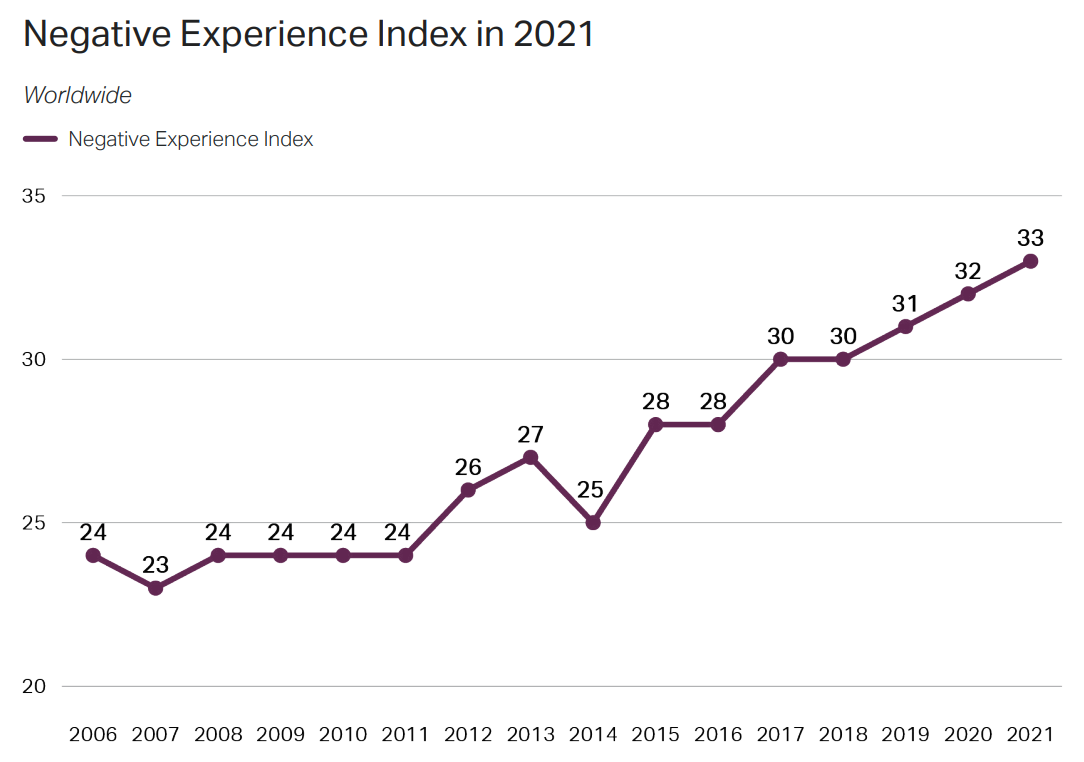
By Julie Ray
28 June 2022
WASHINGTON, D.C. (Gallup) – Emotionally, the second year of the pandemic was an even tougher year for the world than the first one, according to Gallup’s latest annual global update on the negative and positive experiences that people are having each day.
As 2021 served up a steady diet of uncertainty, the world became a slightly sadder, more worried and more stressed-out place than it was the year before — which helped push Gallup’s Negative Experience Index to yet another new high of 33 in 2021.
As it does every year, Gallup asked adults in 122 countries and areas in 2021 if they had five different negative experiences on the day before the survey — and compiled the results into an index. Higher scores on the Negative Experience Index indicate that more of a population is experiencing these emotions.
In 2021, four in 10 adults worldwide said they experienced a lot of worry (42%) or stress (41%), and slightly more than three in 10 experienced a lot of physical pain (31%). More than one in four experienced sadness (28%), and slightly fewer experienced anger (23%).
Already at or near record highs in 2020, these experiences of stress, worry, and sadness ticked upward in 2021 and set new records. Worry rose two points, while stress and sadness increased one point each. The percentage of adults worldwide who said they experienced pain also rebounded two percentage points, matching levels more in line with previous years’ estimates.
However, there was one bright spot: Reports of anger did not increase in 2021, dropping a single point from 24% in 2020.
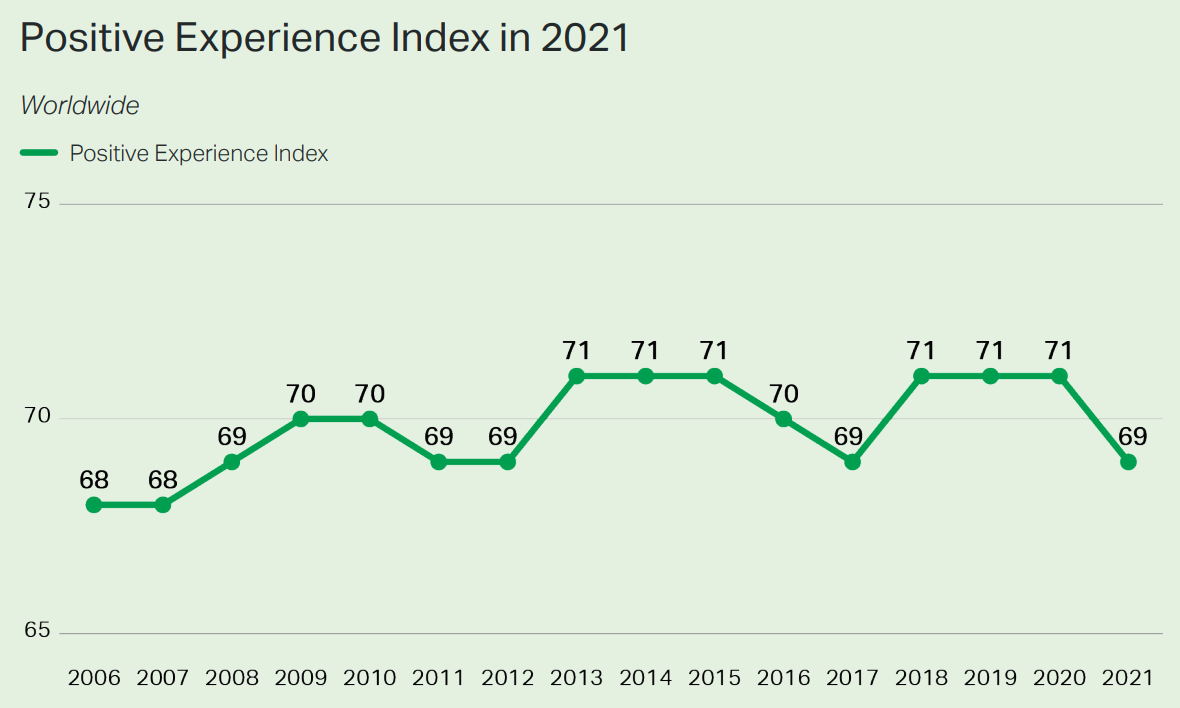
Positive Experience Index drops for first time in years
On top of the increase in negative experiences, fewer people reported that they had positive experiences the previous day. After several years of stability, the Positive Experience Index score in 2021 — 69 — dropped for the first time since 2017.
The Positive Experience Index is based on people’s responses to five questions about positive experiences they had the day before the survey. Higher scores indicate that more of the population reported experiencing these emotions.
Last year, roughly seven in 10 people worldwide said they felt well-rested (69%), experienced a lot of enjoyment (70%), or smiled or laughed a lot (72%). Nearly nine in 10 felt treated with respect (86%). People were far less likely, as they are typically, to say they learned or did something interesting the day before the interview; in 2021, half of the world (50%) experienced this.
Our emotions might also take us to the streets. As negative emotions have increased globally, so has civil unrest. According to the Global Peace Index, riots, strikes and anti-government demonstrations increased 244 percent from 2011 to 2019. In 2020, unrest increased exponentially, with 15,000 protests estimated globally.
Jon Clifton, CEO of Gallup
All over the world, people are trying to understand the rise of violence, hatred, and increased radicalization. They will continue to argue over what the best policy responses should be and what role social media plays in fueling negative emotions. However, policymakers must understand why so many more people are experiencing unprecedented negative emotions and focus on the drivers of a great life.
With more people dying from the coronavirus in 2021 than the previous year despite the rollout of vaccines, people felt less well-rested, and fewer derived enjoyment from the previous day. The percentage who said they felt well‑rested dropped three points, and the percentage who experienced a lot of enjoyment dropped two.
However, the picture wasn’t entirely bleak. People were starting to smile and laugh again — the percentage who laughed or smiled a lot increased two points — and the percentage who learned something interesting ticked up one point.
Afghanistan is the least positive and leads the world in negative experiences
Afghans’ lives were already in a tailspin before the Taliban returned to power in 2021. Most Afghans were struggling to afford food and shelter, few felt safe, and they saw their lives getting worse with every passing year.
But as bleak as this picture is, Gallup surveys conducted in August and September — as the U.S. withdrew and the Taliban took control — reveal Afghans were losing the remaining joy that they had.
Afghanistan has ranked as the least-positive country in the world every year since 2017, apart from 2020, when Gallup could not survey the country because of the pandemic. However, the country’s score of 32 in 2021 on the Positive Experience Index represents not only a new low for Afghanistan, but also a new low for any country that Gallup has surveyed over the past 16 years.

Positive daily experiences were already in limited supply before the Taliban seized control, but these emotions largely disappeared from Afghanistan in 2021. The percentage of Afghans who said they felt enjoyment, smiled or laughed, learned something interesting, or felt well-rested the previous day all dropped to new record lows.
Afghanistan in 2021 displaced Iraq from the top spot on the Negative Experience Index that the latter had occupied for the two previous years. Afghanistan’s score of 59 on the index was the highest score on record for the country and the highest score in the world in 2021. However, Afghanistan falls short of having the highest score on record for any country: The Central African Republic posted a score of 61 in 2017.
Worry, stress and sadness soared to record levels in Afghanistan in 2021: 80% of Afghans were worried, 74% were stressed, and 61% felt sadness much of the previous day. Notably, no other population in Gallup’s 16‑year trend has ever reported feeling this much worry.
Implications
In the second year of the pandemic, people were living with even more uncertainty than the previous year — with more people dying from COVID-19 despite the rollout of vaccines. Yet, the pandemic is not entirely to blame for the increase in negative emotions. Gallup’s data show that the world has been on a negative trajectory for a decade.
However, the continued rise in negative experiences in 2021, in tandem with the decline in positive experiences, suggest it is even more imperative for policymakers to understand why the world is on this course and to look for ways they can change the path it is headed down.
- Read the full 2022 Global Emotions Report.
- For complete methodology and specific survey dates, please review Gallup’s Country Data Set details.
- Learn more about how the Gallup World Poll works.
World Unhappier, More Stressed Out Than Ever
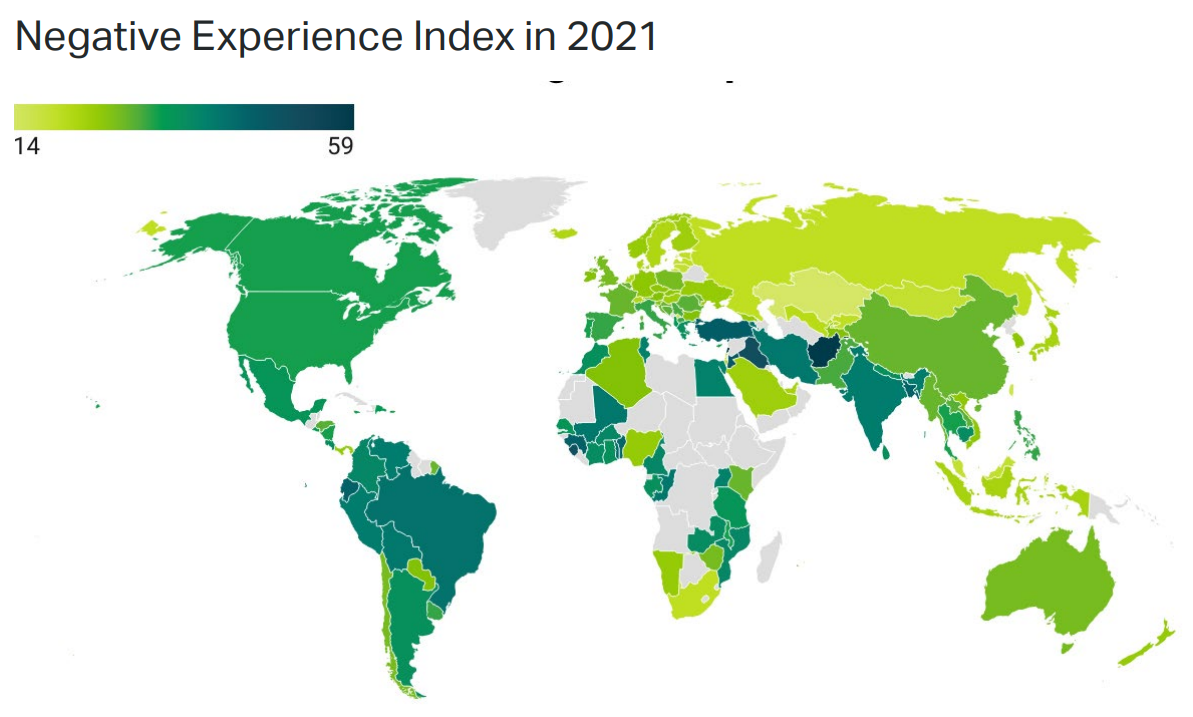
From Gallup’s CEO
By Jon Clifton
28 June 2022
WASHINGTON, D.C. (Gallup) – The world broke a lot of records in 2021. Corporate profits, venture capital funding, CO2 emissions and the temperature of the oceans all reached record highs last year. But there is another record the world broke that hasn’t yet made headlines — and it has to do with how everyone feels.
As you’ll read in this report, in 2021, negative emotions — the aggregate of the stress, sadness, anger, worry and physical pain that people feel every day — reached a new record in the history of Gallup’s tracking.
This record may not be surprising. The world is suffering from war, inflation and a once‑in‑a-lifetime pandemic. Any one of those would make the world worse, but the global rise of unhappiness started long before any of those issues made headlines. In fact, unhappiness has been rising for a decade.
Many things make people unhappy, but there are five significant contributors to the rise of global unhappiness: poverty, bad communities, hunger, loneliness and the scarcity of good work. Two billion people live on insufficient incomes and another 2 billion are so unhappy with where they live, they wouldn’t recommend it to anyone they know.
Poverty’s contribution to global suffering is not particularly revelatory, but this is: the rise of global hunger. According to the United Nations Food and Agriculture Organization, the decline in world hunger over the past few decades is over. In 2014, 22% of people globally were moderately or extremely food insecure; now, that figure is 30%.
The world is also struggling from a silent pandemic — loneliness. Gallup finds that 330 million adults go at least two weeks without talking to a single friend or family member. And just because some people have friends, it doesn’t mean they have good friends. One‑fifth of all adults do not have a single person they can count on for help.
Global misery is also increasing because of an everyday aspect of life — work. Many believe that a good, solid paycheck satisfies your work needs when in fact people who are miserable at work are statistically more likely to experience negative emotions than someone who has no work at all.
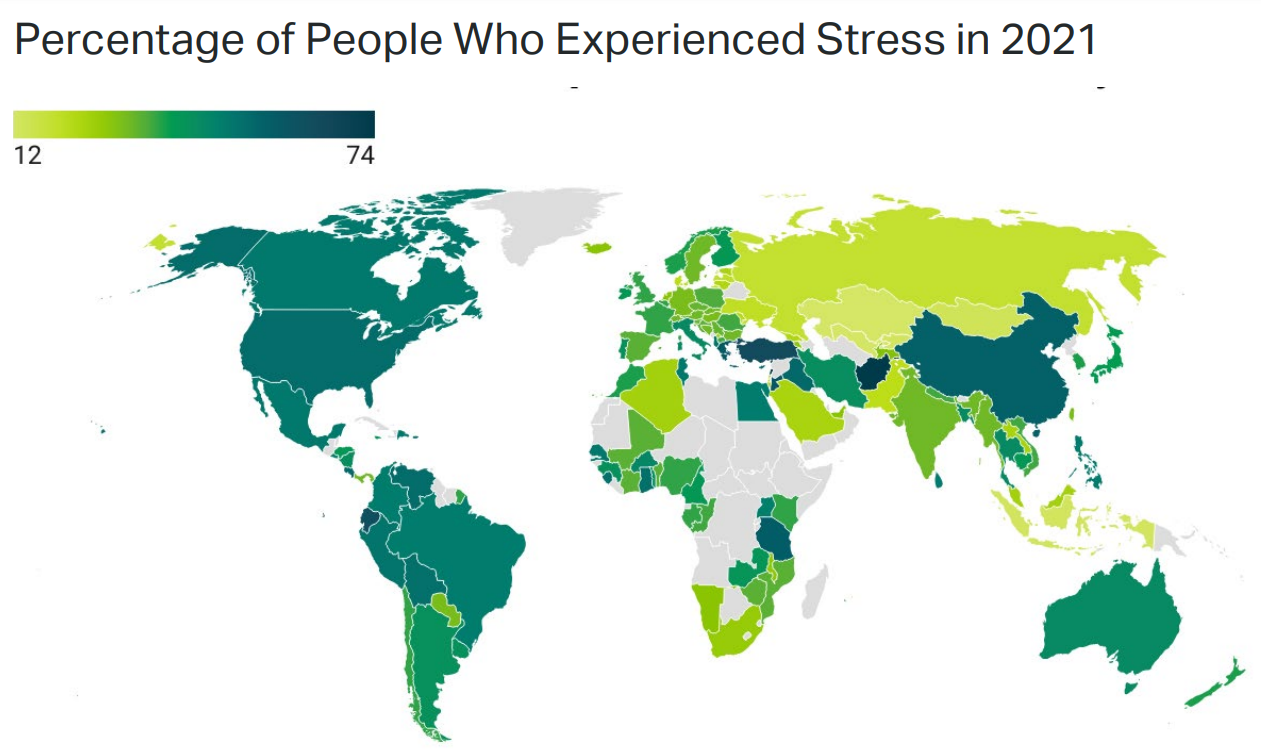
Hardened souls may not care about unhappy people, but they should. A world filled with negative emotions makes people behave differently. Our emotions influence our decisions, actions and even our cognition — sometimes for better, sometimes for worse. But when our bodies and minds are overwhelmed with the worst emotions, our chances of making regrettable decisions increase. And acting out on negative emotions spreads negative emotions faster than a virus, especially when amplified over social media.
MIT behavioral scientist George Ward thinks our emotions guide our decision-making at the ballot box. Using decades of research, he believes he can predict the outcomes of elections and an increase in populist sentiment by looking at the mood of a populace.
Our emotions might also take us to the streets. As negative emotions have increased globally, so has civil unrest. According to the Global Peace Index, riots, strikes and anti-government demonstrations increased 244% from 2011 to 2019. In 2020, unrest increased exponentially, with 15,000 protests estimated globally.
All over the world, people are trying to understand the rise of violence, hatred, and increased radicalization. They will continue to argue over what the best policy responses should be and what role social media plays in fueling negative emotions. However, policymakers must understand why so many more people are experiencing unprecedented negative emotions and focus on the drivers of a great life.
Our shared humanity and wellbeing depend on it.
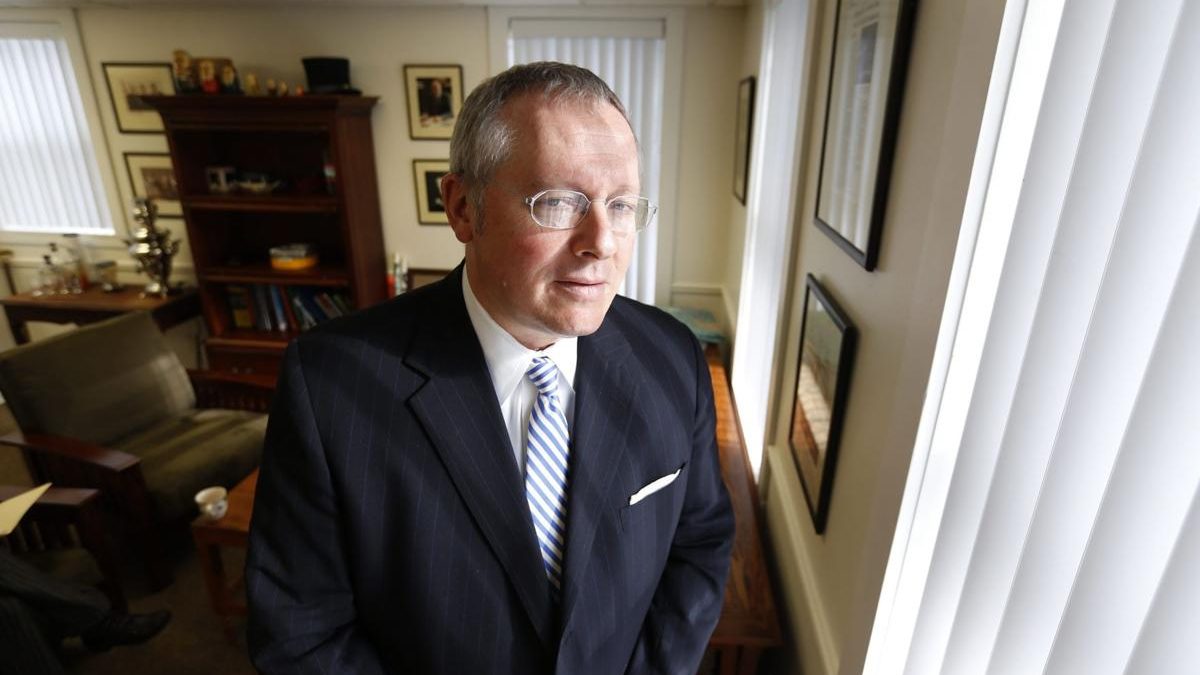

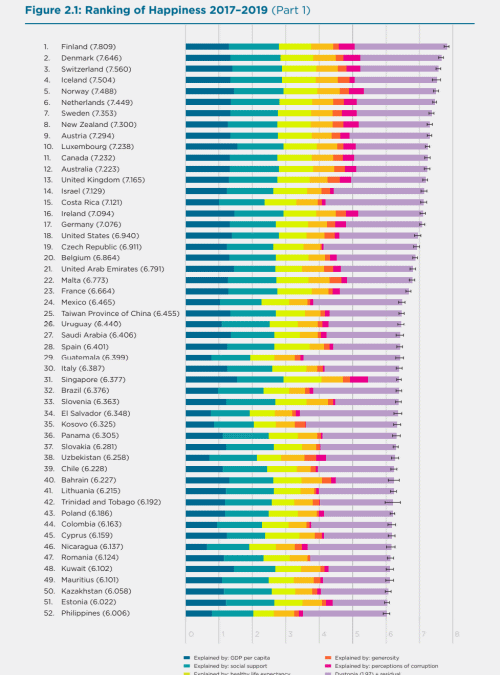
One Response
Comments are closed.